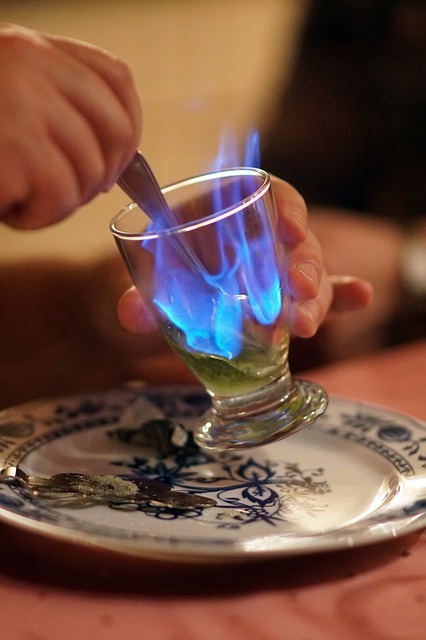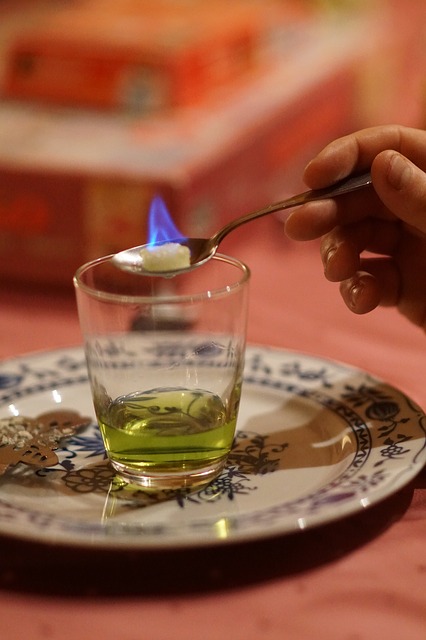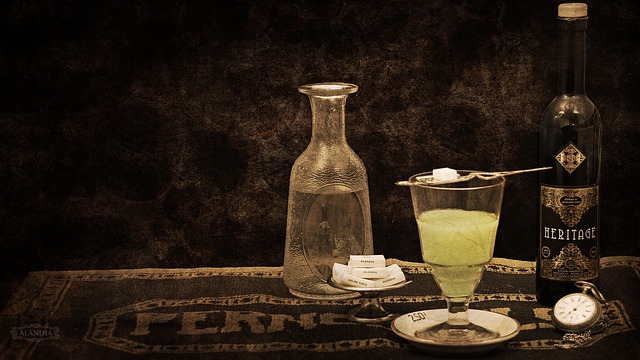What exactly is Absinthe?
Absinthe or in some countries called “vermouth spirits”, is an alcoholic beverage made from wormwood, fennel, anise and a number of other herbs. Since most Absinthmarken have a green color, the brew is often called La fée verte, to German The Green Fairy. The alcohol content is approximately between 45 and 85 percent by volume and therefore belongs to the harder alcohol segment. Due to the bitter herbs used for production, such as wormwood, absinthe is referred to as bitter spirit, but it does not taste really bitter.
Absinthe and its infamous story
As the consumption of absinthe finally boomed, the liquor came into disrepute because of its thujone content and to have negative health effects. As a result, in 1915, the production and consumption of the beverage was banned in the US and other European countries.
 Damage caused by absinthe consumption could not be proven in modern studies. Rather, the health damages that occurred at that time are due to the inferiority of the alcohol. It was not uncommon for it to contain amyl alcohol and other fusel oils. Methanol, which causes dizziness, headaches and can be fatal if overdosed, was formerly buried in absinthe. On the whole, however, the observed side effects are simply attributable to the high alcohol consumption. When it emerged that the moderate enjoyment of the drink was by no means questionable, since 1998 absinthe has been reintroduced in most European countries. In the country of origin of Absinthe, Switzerland, the production and sale of the spirit was not allowed until 2005.
Damage caused by absinthe consumption could not be proven in modern studies. Rather, the health damages that occurred at that time are due to the inferiority of the alcohol. It was not uncommon for it to contain amyl alcohol and other fusel oils. Methanol, which causes dizziness, headaches and can be fatal if overdosed, was formerly buried in absinthe. On the whole, however, the observed side effects are simply attributable to the high alcohol consumption. When it emerged that the moderate enjoyment of the drink was by no means questionable, since 1998 absinthe has been reintroduced in most European countries. In the country of origin of Absinthe, Switzerland, the production and sale of the spirit was not allowed until 2005.
Absinthe Preparation: So you drink it properly
In principle, absinthe, similar to the aniseed spirits Ouzo or Pastis, diluted with water consumed. The clear liquid gets a milky-cloudy color. Over time, different drinking styles and rituals have evolved from absinthe. The best known are the Swiss drinking method, the French drinking ritual and the Czech fire ritual. All have in common that the absinthe in the ratio 1: 1 to 1: 5 diluted with ice water, the standard ratio is 1: 3.
 The French drinking ritual is the only one that has a historically proven tradition. From the 19th century until its prohibition in the 20th century, the spirit was drunk in France with sugar. One to two pieces of sugar are placed on a special Absinthe spoon and poured very gently with cold water. The mixing ratio is in this preparation variant at 1: 3 to 1: 5.
The French drinking ritual is the only one that has a historically proven tradition. From the 19th century until its prohibition in the 20th century, the spirit was drunk in France with sugar. One to two pieces of sugar are placed on a special Absinthe spoon and poured very gently with cold water. The mixing ratio is in this preparation variant at 1: 3 to 1: 5.
A high entertainment factor brings the Czech drinking with, which has no historical roots. It was developed by a Czech absinthe producer in the 1990s to make the drink more attractive and saloon-friendly.
Here are one to two pieces of sugar cubes, which were previously soaked in absinthe, placed on an absinthe spoon and lit. When the sugar begins to caramelize and bubbles, the flames are extinguished. The sugar is added to the drink only after completion of this procedure. In this preparation variant, however, great caution is necessary: If still burning pieces of sugar into the glass, it may well happen that also ignites the remaining absinthe. Also in this case, the mixing ratio is 1: 3 to 1: 5.
The least established is the Swiss drinking style. As the absinthes available in Switzerland are less bitter than the French, the addition of sugar is not required. Likewise, only two to four centiliters of the spirit drink are mixed with water.
Drinking tip: Absinthe can also be enjoyed undiluted with ice.
Absinthe and its effect
According to consumer reports, the enjoyment of several glasses of absinthe triggers an incomparable intoxication. It is reported to have a slightly hover-like feel, which is probably due to a mixture of thujone and alcohol. It is also interesting that the sensory perception is perceived as sharpened. Also, colors appear more intense or stronger and sounds are perceived louder. The state of mind is described as euphoric, excited and / or omitted.
Can absinthe be overdosed?
In general, poisoning with absinthe is not possible. In order to achieve the required dose of 2 to 10 g of thujone, about 200 bottles of absinthe would have to be consumed. In addition, since 1998, there is a separate spirit drink law in the EU, which prescribes a maximum thujone content of 35 mg per liter. Caution should be exercised so rather in terms of the alcohol content of the absinthe and the amount of it enjoyed.
The best absinthe: This is how you differentiate the real absinthe of faux-books
Absinthe is not everywhere absinthe is on it. Because the term “absinthe” is not protected, so there is no fixed definition of what ingredients and manufacturing processes must be given so that a liquor may carry this name. Attempts to protect the name have failed so far.
Genuine absinthe or original absinthe
The real absinthe consists of natural, dried herbs. He is macerated over several days in a complex procedure, distilled, dyed and then stored long until he has reached the appropriate maturity. Traditional absinthe recipes contain neither sugar nor artificial colors. The original Absinth is therefore a completely natural, handmade product and starts at about 50 € per liter.

Fauxsinthe or trend absinthe
False absinthes are mixtures of alcohol (mostly vodka) and a liquid herbal essence. Among other things, they can be recognized by the fact that they contain sugar and are artificially colored. In addition, spurious Absinthe are also high percentage than real and bring a maximum of a neat hangover.
Another distinctive sign that it is an absinthe counterfeit is either skull-shaped bottles, labels with skulls or marijuana leaves, as well as packaging that advertises an extremely high alcohol or thujone content. In addition, faux-heels are not artisanal, not distilled and always have an unnatural, shrill color – for example, shrill green, black, bright red, bright yellow or blue.
